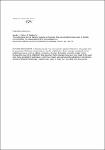The mglA gene and its flanking regions in Brucella: The role of mglA in tolerance to hostile environments, Fe-metabolism and in vivo persistence
Jacob, Jens
Finke, Antje
Mielke, Martin
We previously demonstrated that a spontaneous smooth small-colony variant of Brucella abortus S19 is characterized by increased in vivo persistence and the differential expression of a gene predicted to encode a galactoside transport ATP binding protein (mglA). In order to further investigate the role of this gene in the context of its flanking regions, we analyzed the respective DNA sequences from the formerly described B. abortus S19 as well as from avirulent B. neotomae 5K33 and compared these with published data from other Brucella species. Deletion mutagenesis of mglA in the large-colony variant of B. abortus S19 resulted in increased tolerance of the deletion mutant to a hyperosmotic (toxic), galactose-containing medium as well as to oxidative stress (H2O2). Whilst the deletion mutant is characterized by reduced growth on solid Fe3+-containing minimal medium (small-colony morphology), in vivo studies in mice demonstrated statistical significant differences in the bacterial load of spleens in the pre-immune, but not in the late phase of the infection.
No license information

